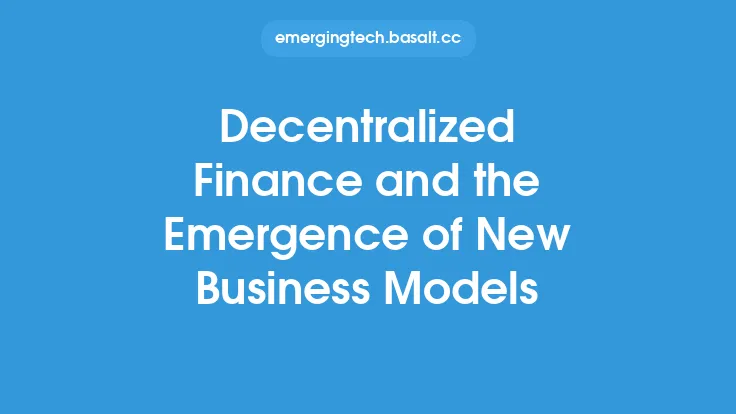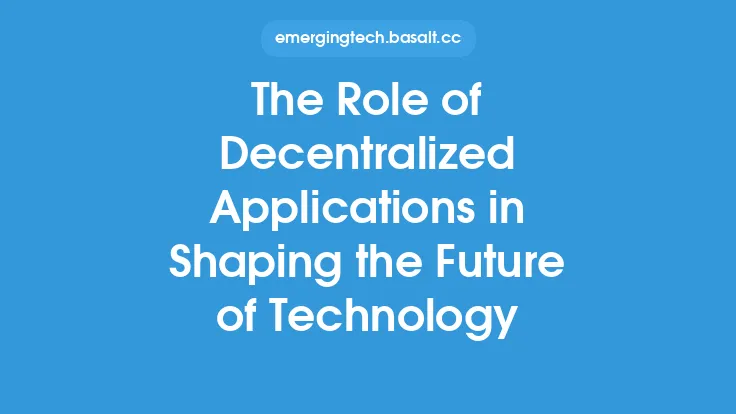Decentralized finance, commonly referred to as DeFi, is a rapidly growing sector of the financial industry that leverages blockchain technology and cryptocurrencies to create a more open, accessible, and transparent financial system. At its core, DeFi aims to disrupt traditional finance by providing an alternative to conventional financial institutions and instruments, offering users greater control over their financial transactions and data. In this guide, we will delve into the fundamentals of DeFi, exploring its key concepts, benefits, and components, as well as the opportunities and challenges it presents.
Introduction to DeFi Concepts
DeFi is built on a set of core principles that differentiate it from traditional finance. One of the foundational concepts of DeFi is decentralization, which means that financial services and transactions are not controlled by a single entity or institution. Instead, DeFi applications (dApps) operate on blockchain networks, allowing for peer-to-peer transactions without the need for intermediaries. This decentralization is facilitated by smart contracts, which are self-executing contracts with the terms of the agreement written directly into lines of code. Smart contracts enable the automation of various financial processes, making DeFi applications more efficient and transparent.
Key Components of DeFi
Several key components make up the DeFi ecosystem, each playing a crucial role in its functionality and growth. Cryptocurrencies, such as Ethereum, are the backbone of DeFi, serving as the medium of exchange and the basis for creating and trading various digital assets. Stablecoins, a type of cryptocurrency pegged to the value of a traditional asset (like the US dollar), are also integral to DeFi, as they provide a stable store of value and medium of exchange, reducing the volatility often associated with other cryptocurrencies. Additionally, decentralized exchanges (DEXs), liquidity pools, and lending protocols are essential components of DeFi, enabling users to trade, borrow, and lend assets in a decentralized manner.
Benefits of DeFi
The DeFi space offers several benefits over traditional finance, including increased accessibility, transparency, and security. DeFi applications are open to anyone with an internet connection, allowing individuals from around the world to access financial services that may be unavailable or inaccessible in their local markets. The use of blockchain technology also ensures that all transactions are recorded on a public ledger, making the entire process transparent and traceable. Furthermore, the decentralized nature of DeFi reduces the risk of censorship and the control of a single entity over financial transactions, enhancing user autonomy and security.
DeFi Applications and Use Cases
DeFi has a wide range of applications and use cases, from simple trading and lending platforms to more complex financial instruments and services. Decentralized lending platforms, for example, allow users to borrow and lend cryptocurrencies, while decentralized exchanges enable the trading of various digital assets. Other DeFi applications include yield farming, which involves lending or providing liquidity to generate returns, and decentralized finance aggregators, which simplify the process of navigating and interacting with multiple DeFi protocols. These applications and services are continually evolving, demonstrating the versatility and potential of DeFi to transform various aspects of the financial industry.
Challenges and Limitations
Despite its potential, DeFi also faces several challenges and limitations. Regulatory uncertainty is one of the significant hurdles, as the legal and regulatory frameworks surrounding DeFi are still in their infancy and vary greatly from one jurisdiction to another. Security risks are another concern, with smart contract vulnerabilities and liquidity pool exploits being notable examples of potential threats. Additionally, the complexity of DeFi applications and the volatility of cryptocurrency markets can make it difficult for new users to navigate and understand the space. Scalability issues also affect many DeFi platforms, limiting their ability to handle a large volume of transactions efficiently.
Conclusion
Decentralized finance represents a significant shift in the way financial services are provided and accessed, offering a more decentralized, transparent, and accessible alternative to traditional finance. While DeFi presents numerous opportunities for innovation and growth, it also comes with its set of challenges and limitations. As the DeFi space continues to evolve, it is crucial for users, developers, and regulators to work together to address these challenges and ensure that DeFi realizes its full potential to transform the financial industry. By understanding the core concepts, components, benefits, and challenges of DeFi, individuals can better navigate this emerging sector and contribute to its development and adoption.





